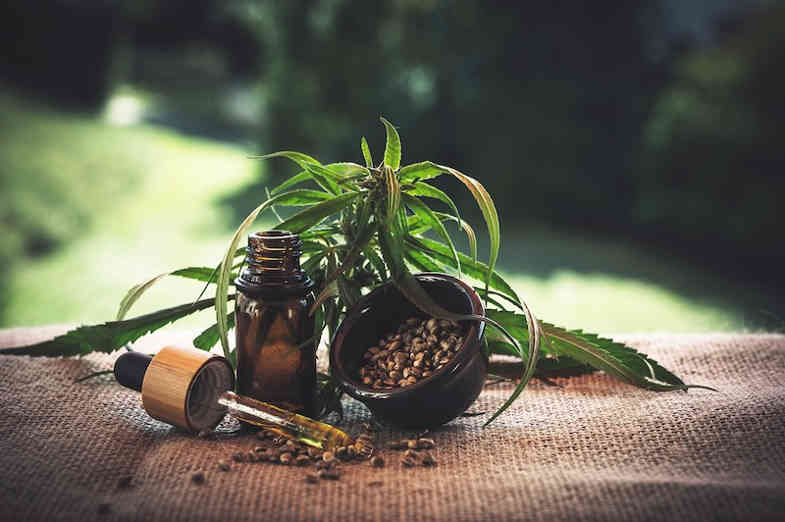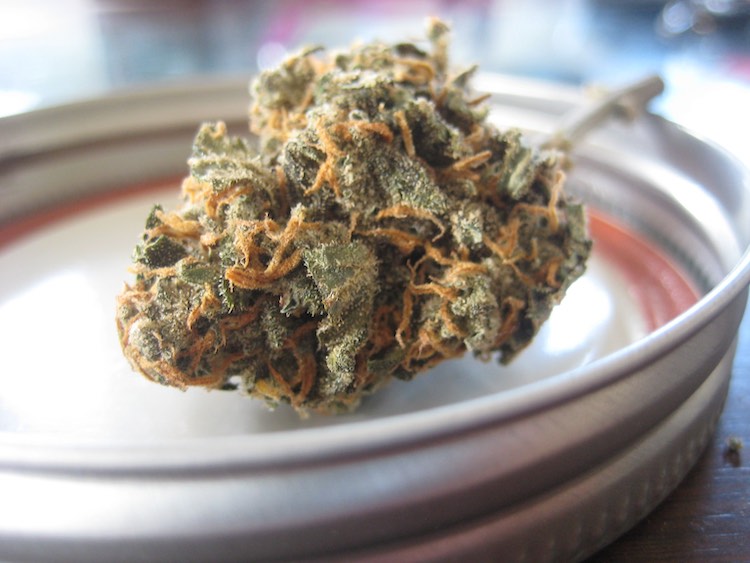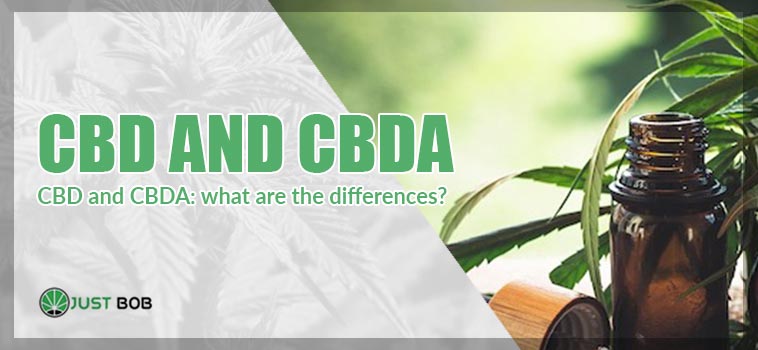Modified on: 20/03/2025
Differences between cbd and cbda: What and which are the effects
Cannabis is composed of specific organic compounds that have been objects of research and studies to understand what are the effects they produce on consumers and their main properties to make the most of them.
The legalization of hemp also boosted the CBD cannabis market, focusing people’s interest in the main compounds it contains the CBD and the CBDA.
But what are the differences between these active ingredients of raw cannabis plants and what are they?

What is a cannabinoid?
A cannabinoid is a naturally occurring compound found in the cannabis plant, particularly in hemp plants and marijuana plants. These compounds interact with the body’s endocannabinoid system, a complex regulatory system that plays a crucial role in maintaining homeostasis.
Two prominent cannabinoids are cannabidiol (CBD) and cannabidiolic acid (CBDA). CBD is often extracted from hemp plants and is a key ingredient in various CBD products like CBD oil, hashish, and tinctures. CBDA, on the other hand, is the acidic precursor to CBD found in raw, hemp oil.
The endocannabinoid system comprises cannabinoid receptors that are scattered throughout the body. CBD interacts with these receptors, influencing various physiological processes and potentially offering a range of health benefits. CBDA also shows promise in interacting with serotonin receptors and may have potential benefits, including pain relief.
When hemp or cannabis users consume raw cannabis or hemp juice, they are exposed to both CBDA and CBD in their raw form. In this state, CBDA inhibits certain processes and converts into CBD through decarboxylation, a process that removes the carboxylic acid group from CBDA.
The potential benefits associated with cannabinoids, including CBD and CBDA, are diverse and include pain relief, anti-inflammatory effects, and potential applications in medical cannabis for conditions like chemotherapy-induced nausea. Unlike THC (tetrahydrocannabinolic acid), another cannabinoid found in recreational cannabis, CBD and CBDA do not induce psychoactive effects commonly associated with recreational cannabis use.
CBD products, ranging from oils and tinctures to topical creams, are created by extracting and isolating CBD from cannabis plants. This process ensures that CBD is available in a concentrated and usable form for consumers seeking its potential benefits.
In summary, cannabinoids like CBD and CBDA are naturally occurring compounds found in the cannabis plant, offering a range of potential benefits when interacting with the body’s endocannabinoid system. The distinction between CBD and CBDA lies in their form – CBD is the converted, active form acidic cannabinoids, while CBDA is the raw, acidic precursor. These compounds hold promise for various applications, from health and wellness products to potential therapeutic uses in medical cannabis.
Cannabis Plant: Exploring Major Cannabinoid Precursor Compounds
The cannabis plant, particularly the hemp plant, is a rich source of major cannabinoid precursor compounds, laying the foundation for a diverse array of CBD products and potential health benefits. Understanding the distinctions between acidic cannabinoids, such as CBDA (cannabidiolic acid), and their converted forms, like CBD, is crucial for unlocking the full spectrum of therapeutic potential.
In its raw form, the cannabis plant, specifically the cannabis sativa plant, harbors both CBD and CBDA. CBD (cannabidiol) and CBDA (cannabidiolic acid) are chemical precursor compounds, each offering unique benefits and interacting with the body’s endocannabinoid system in distinctive ways.
Raw cannabis plants, when subjected to various extraction methods, yield both CBD and CBDA oils. CBD oil, celebrated for its potential health benefits including pain relief and anti-anxiety effects, is a staple in the realm of CBD products. On the other hand, CBDA, which stands for cannabidiolic acid, is gaining attention in the scientific community for its unique benefits.
CBDA, found abundantly in raw cannabis, shows promise in interacting with serotonin receptors and the central nervous system. Scientific research suggests that CBDA may have anti-anxiety effects, making it an intriguing compound for further exploration in the context of mental health.
One notable difference between CBDA and CBD is that CBDA is the acidic precursor of CBD. The conversion process involves decarboxylation, where heat removes the carboxylic acid group from CBDA, transforming it into CBD. This transformation occurs naturally over time or can be induced through various processing methods.
Full spectrum CBD buds products, derived from the same hemp or hemp plant or material, retain both CBD and other cannabinoids, including their acidic forms like CBDA. This comprehensive approach capitalizes on the entourage effect, where the combined presence of various cannabinoids enhances their overall therapeutic potential.
Consumers can find CBDA in various products, from raw cannabis juices to CBDA capsules. Some even choose to consume the raw cannabis juice, for its potential health benefits in its unprocessed form. Additionally, CBDA interacts uniquely with cannabinoid receptors in the body, offering a distinctive experience compared to CBD.
For those seeking CBD benefits, it’s essential to understand the difference between CBDA and CBD. While CBD is more prevalent in most CBD products, some argue that the inclusion of CBDA may contribute to the overall effectiveness of these products.
In conclusion, the cannabis plant, with its abundant cannabinoid precursor compounds, holds promise for a range of therapeutic applications. Whether exploring the benefits of CBD, CBDA, or other cannabinoids, the cannabis plant’s complex molecular structure continues to captivate the scientific and medical communities, offering a wealth of possibilities for health and wellness.

CBDA: what it is and what are its characteristics
CBD weed has been the subject of interest from research institutes to understand how it interacts with our body, releasing beneficial effects.
Among the various substances present in it there is the CBDA, which is a cannabidiol acid, closely related to CBD since it is the substance from which the cannabidiol itself is formed.
CBDA is present in the glands of the resin, it is to say the trichomes, in cannabis and hemp plants, that are the raw juices not heated or polymerized.
Through a process of decarboxylation that takes time and high temperatures, the CBDA acid group degrades and conversion to CBD takes place.
In general, cannabidiol acid is considered an inactive compound, but in reality, the research is demonstrating the beneficial properties that derive from its intake.
Read also: Lemon haze marijuana light: all you need to know about it
What are the benefits of CBDA?
Firstly, CBDA and CBD are derived from the same hemp plant. CBDA stands as the acidic precursor to CBD, and the conversion process occurs when raw hemp undergoes decarboxylation, shedding the acidic carboxyl group and transforming CBDA into CBD. This conversion is crucial for creating CBD products, such as CBD oil and tinctures, which are widely recognized for their potential therapeutic applications.
CBDA’s potential benefits are thought to arise from its interaction with the endocannabinoid system, a complex regulatory system within the body. Although CBDA’s precise mechanisms are still being explored, it shows promise in interacting with the system’s receptors, suggesting potential health benefits.
One notable aspect is the potential role of CBDA in interacting with cannabinoid receptors and other plant compounds. Unlike CBD, CBDA appears to inhibit certain processes in its raw state, and ongoing research is exploring how this inhibition may contribute to its unique effects.
For consumers seeking the potential benefits of CBDA, products specifically formulated to preserve this acidic cannabinoid are available. CBDA oils and tinctures allow individuals to consume CBDA directly, providing an alternative to CBD products. Some users may prefer CBDA products for specific purposes or to explore its potential benefits in conjunction with CBD.
Research suggests that CBDA may have potential applications in supporting chemotherapy patients, as well as interacting with the body’s endocannabinoid system to offer relief. As one of the most abundant cannabinoid acids in the hemp plant, CBDA’s unique properties are becoming increasingly recognized within the scientific and medical communities.
In summary, CBDA stands as an intriguing compound with potential benefits that differentiate it from its converted counterpart, CBD. As research progresses, a deeper understanding of CBDA’s interactions within the body’s endocannabinoid system and its unique advantages may unlock new possibilities for harnessing the full potential of the hemp plant’s diverse array of compounds.
CBD: what it is and what advantages it offers
The CBD has attracted more interest from scientific communities than its precursor, the CBDA.
It is always a non-psychoactive substance, and therefore different from THC, another of the most important active ingredients contained in cannabis.
Cannabidiol is also applied in the medical field due to the beneficial properties it releases on consumers.
It is also important to emphasize that it does not affect the mental and physical state of those who use it but simply causes a state of calm and relaxation.
No known side effects caused by this active ingredient have been identified and it is, of course, what made CBD flowers legal.
In the case of coexistence between cannabidiol and tetrahydrocannabinol (CBD and THC), CBD acts to counteract the psychophysical alterations deriving from THC.
Through this, we understand that this non-psychoactive compound stimulates the production of glutamate and dopamine and it can be used for medicinal purposes.
It acts as an anti-inflammatory, pain reliever, antipsychotic and also, it is used to fight anxiety and regulate the sleep cycle.
CBD and CBDA: differences
The CBDA has strong links with CBD since it is cannabidiol in acid form.
Nevertheless, the studies have focused more on the compound considered active, which is the cannabidiol itself.
Both are substances that do not influence the psychophysical state of consumers and, in reality, are considered to have very similar effects.
The CBDA, like the CBD, can be used as:
- Anti-inflammatory;
- Painkiller;
- Antibacterial;
- Remedy for anxiety and stress.
Since 2012, research has been carried out on the action of CBDA on our body, in fact, it is concretely proving how this possesses an enzyme capable of inhibiting the migration of tumor cells, and this especially affects women predisposed to breast cancer.
The subject is still being studied in-depth, but it is important to know that the interaction between the different cannabinoids can be more efficient than taking just one.
Read also: Are marijuana and cannabis the same thing?
How to intake CBD and CBDA
The vast success of CBD cannabis has made possible a wide choice of how to take the substance.
The method preferred by consumers is the use of CBD oil which is assumed by releasing a few drops under the tongue.
Look for suitable cannabis oils combined with other ingredients such as Omega3, various antioxidants, and CBDA to take full advantage of the benefits of a natural product.
The prelingual intake is also rapid and powerful because it acts quickly on our bodies.
Also about these products, no side effects have been identified but moderate and controlled use is always recommended based on one’s physical needs.
CBD oils are also integrated into the diet because they help regulate the metabolism and are rich in nutritional values.
Beyond oils, CBD can be taken in the form of:
- creams
- capsules
- liquids for electronic cigarettes
- crystals
- chewing gum
This demonstrates the exponential growth that the product has achieved in recent years, so the market has made available various legal and safe products to use to satisfy all the needs of consumers.
CBD and CBDA: conclusions
CBDA and CBD act positively on our system, and through different administration systems, including CBD oil, it is possible to make the most of the beneficial properties of these active ingredients of the cannabis flower.
The fields of application of the CBD appear numerous, which has now also reached the veterinary branch.
For example, it is possible to administer CBD oil to dogs and other animals to relieve chronic pain or to combat separation anxiety.
This demonstrates that making sure that you have purchased a natural product whose compositions and extraction methods are known, it is possible to relax or take care of physical problems in a completely simple and legal way.





